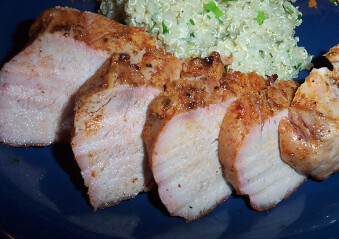Experiments in brining

I don't often eat red meat at home, because my husband is intolerant to it. This isn't to say that he's a radical vegetarian, but his digestive system tends to... reject all things beef, pork and lamb. I'm an inveterate carnivore, though, so I occasionally buy some meat on a whim, and throw it in the freezer until the spirit moves me to cook it (and cook something else for him).
This particular story is about some pork tenderloins I had bought a few weeks ago. When we returned from vacation, we found ourselves smack in the middle of barbecue season, but I get easily bored with our usual selection of sausages and President's Choice burgers. So this isn't so much a "made from scratch" thing as a "what I had for dinner" thing. But we never make the burgers or sausages from scratch, so maybe this is a "made from scratch" thing!
This was also my first attempt at brining meat. I used the instructions given in Brian Polcyn and Michael Ruhlman's Charcuterie. Because it was my first time using this technique, I wanted to keep things to their most basic, so I avoided using any aromatics and stuck to the basic brine, though I did use brown sugar instead of white. I figured I could always use a dry rub after the fact.
Then I realized that dry rubs almost invariably call for salt and sugar, which were already provided in the brine. So I ended up just rubbing the tenderloins with olive oil and coating them with some Spanish smoked paprika and black pepper.
The results were delectable! The pork was salty, but not unpleasantly so. (I'm a salt fiend. In fact, my husband keeps threatening to have a salt lick installed to keep me happy!) The paprika lent a wonderful smokey note that I wouldn't otherwise have been able to achieve on my tiny little propane grill. And the meat was incredibly moist.
And what did I cook for my husband? I took some boneless chicken breasts, brined them (separately from the pork, but using the same batch of brine) and grilled them with a glaze made from lime juice, Thai fish sauce and hot red pepper jelly. He tells me it was good, but didn't seem especially enthusiastic about it. I thought there was too much fish sauce in the glaze, but the brine seemed to keep the chicken moist as well.
All in all, I think brining is a technique I'll be using again soon. It's too hot to try it right now, but I'm eager to see what effect it will have on a roast chicken.
Brined pork tenderloin
2 litres water
125 grams kosher salt
75 grams brown sugar
2 pork tenderloins (total about 800g)
vegetable oil (I used olive)
freshly ground black pepper
paprika
1. Mix the brine ingredients in a pot, and bring to a simmer, stirring to dissolve the sugar and salt. Once dissolved, take the pot off the heat, let it cool completely, then put it in the fridge until chilled.
2. Once the brine is chilled, place the tenderloins in the pot, ensuring they are submerged. (I didn't actually need the full quantity of brine for my two tenderloins.) Return the pot and tenderloins to the fridge for two hours.
3. After two hours, remove the pork from the brine, rinse in cold water and pat dry. Place the pork on a clean plate and return to the fridge, uncovered, for at least one hour. Discard the brine.
4. Rub the pork with oil, sprinkle the paprika and black pepper on, and rub in.
5. Grill the pork over medium heat for approximately 15 minutes (or until it reaches an internal temperature of 130 to 140 degrees Fahrenheit), turning once halfway through cooking.
6. Allow to rest for 5 minutes, then slice and serve. (As you can see in the photo, I served mine with quinoa mixed with parsley and green onions.) Enjoy!
I'm planning a post about our trip to Ireland and Italy, but tales grow in the telling, and I'm having a hard time deciding how much detail to provide. Keep checking back!

1 Comments:
At 11:20 PM, Anonymous said…
Anonymous said…
I am a radical vegetarian, and that is some good looking pork my friend... :)
Post a Comment
<< Home